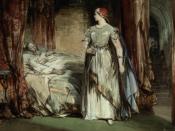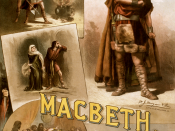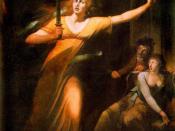Blood in Macbeth
Every good play has a certain elements that make it stand out from the other plays. An important one of these is the use of imagery involved. Good use of imagery can make a play exceptional. It plays a significant role in every play as it helps generating a sense of mood or atmosphere. It also adds dramatic effects to the play. In Macbeth, blood plays an important role in changing the atmosphere from time to time. Shakespeare uses the imagery of blood to represent treason, guilt, murder and death, thus creating a mood in the play and adding dramatic effects to it as well. But most importantly, it symbolizes the guilt that sits like a permanent stain on the conscience of the Macbeths, one that hounds them to their graves.
The word blood, or different forms of it, is mentioned often in the play. Forty-two times to be exact.
Ironically, the word fear also is used the same amount. However, the image of blood changes frequently throughout the play. From bravery, to malice; from guilt to pride.
The first mention of blood is in Act I, scene ii when King Duncan says, "What bloody man is that?" This is symbolizes a heroic warrior, injured in a battle for his country against the Norwegians. The sergeant's reply, "Which smok'd with bloody execution," refers to Macbeth's valor as he covers his sword in the hot blood of the enemy. In this phase of the play, blood corresponds to bravery and courage.
Things, however, change in due course of time. The image of blood changes to treachery. Lady Macbeth, in a soliloquy in Act II, scene ii says, "Make thick my blood." She shows desires to become remorseless about the deeds she is about to commit.



Macbeth blood clothing imagery
i think this essay is really good. right now i am doing macbeth in school and this completly made me understand the concept of clothing imagery
1 out of 1 people found this comment useful.